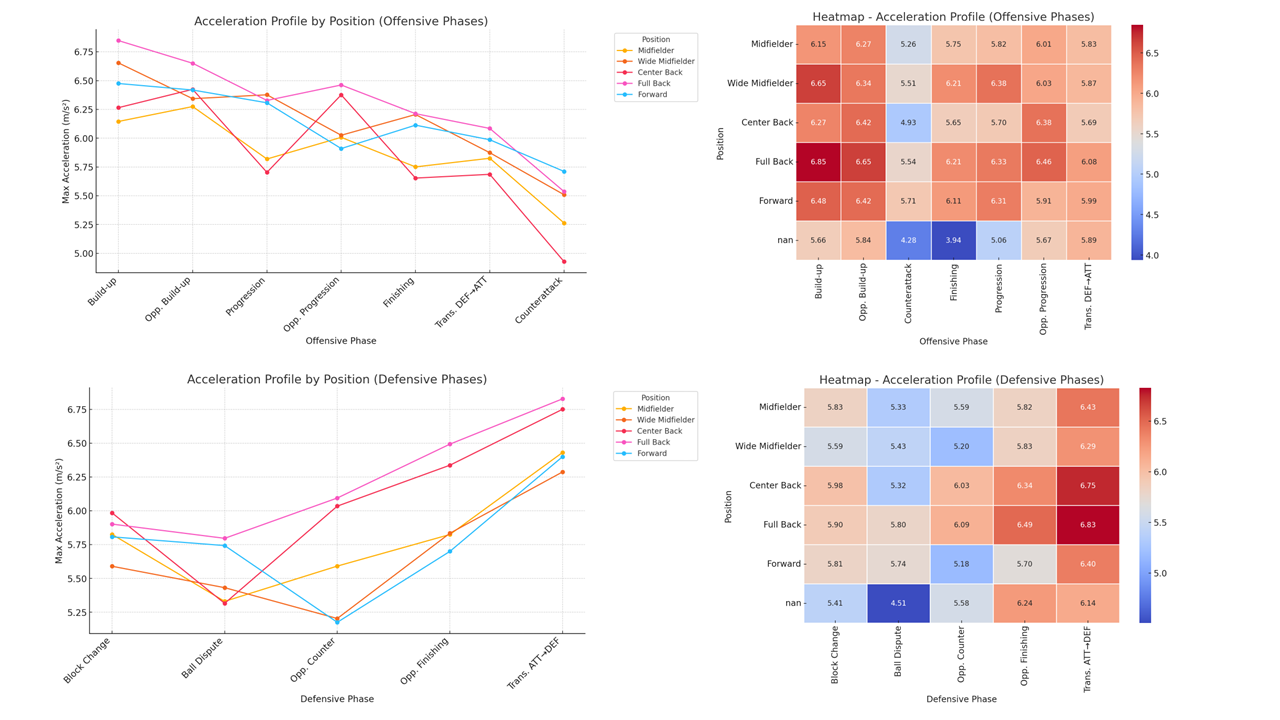
11 Feb Are You Really Measuring Your Players’ Physical Performance Correctly? The Mistake of Evaluating Acceleration Without Context
In football, player acceleration is often analyzed based on general values, without considering their position or the match context. But what happens if a player hasn’t had the opportunity to perform in the phases of play where their acceleration is most crucial? In these cases, their physical performance could be mistakenly interpreted as low, when in reality, the match context has not allowed them to showcase their full potential.
This analysis has been conducted by the Football Intelligence & Performance Department at LALIGA, with the aim of providing a data-driven approach to better understand the physical demands of the game.
One of the most common mistakes in evaluating acceleration is focusing only on whether a player has reached, exceeded, or fallen below their usual maximum acceleration value. This approach is similar to how maximum speed is interpreted, but without considering how often those values have been reached or in what context. If a match has had few situations where a player can exploit their peak acceleration, their performance may seem low when, in reality, it is due to contextual factors.
Our analysis at LALIGA has revealed that differences in acceleration across positions are not random but rather follow well-defined tactical patterns. To correctly evaluate a player’s acceleration, it is essential to consider the match context and the phases where their position demands greater explosiveness.
This study is a continuation of our previous research on the importance of acceleration in modern football. If you haven’t read the first part yet, you can find it here:
Previous study link: https://footballinnovationhub.com/2025/02/06/speed-bro-better-accelerate-what-really-matters-in-modern-football
Now, in this new phase of the analysis, we focus on how acceleration varies according to position and match context.
Methodology: Rigorous Analysis
This study has analyzed the maximum acceleration values in different phases of play during the 2023/24 LALIGA EA SPORTS season. The data has been grouped into two main categories:
? Offensive phase: Build-up, progression, finishing, and offensive transitions.
? Defensive phase: Organization, duels, recovery runs, and defensive transitions.
To ensure the reliability of the study, we applied statistical tests (ANOVA), and only results where positional differences were statistically significant (p < 0.05) are presented.
Below, we analyze in detail how acceleration varies by position.
? Position-Specific Acceleration Analysis
? Center-Backs
? Phases where they accelerate the most: Recovery runs and defending against final attacks.
? Phases where they accelerate the least: Progression and counterattacks.
? Tactical explanation: Their acceleration is crucial in emergency defensive situations, such as correcting positioning after losing the ball or preventing an attacker’s movement. However, their involvement in progression and counterattacks is limited, as they rarely carry the ball at high speed or participate in fast transitions.
? Full-Backs
? Phases where they accelerate the most: Progression, counterattacks, and recovery runs.
? Phases where they accelerate the least: Duels and finishing.
? Tactical explanation: They are key players in fast transitions, both offensively and defensively. In attack, they use their acceleration to gain width; in defense, to regain position and stop opposing advances. However, in duels and finishing, their acceleration is less relevant due to their structural role in the team.
? Midfielders
? Phases where they accelerate the most: Duels and transitions.
? Phases where they accelerate the least: Finishing and counterattacks.
? Tactical explanation: While they do not stand out in maximum acceleration values, their ability to react quickly in possession changes is key to team balance. Their impact on acceleration is lower in finishing and counterattacks, as their main function is to organize play and maintain possession.
? Wingers
? Phases where they accelerate the most: Progression, finishing, and counterattacks.
? Phases where they accelerate the least: Recovery runs and duels.
? Tactical explanation: They are the most explosive attacking players, using their acceleration to beat defenders in one-on-one situations, exploit spaces, and create goal-scoring opportunities. In contrast, their acceleration is lower in recovery runs and duels due to their advanced positioning and lower defensive workload.
? Forwards
? Phases where they accelerate the most: Finishing and counterattacks.
? Phases where they accelerate the least: Recovery runs and progression.
? Tactical explanation: The ability to accelerate in the final meters is crucial for creating goal-scoring chances and capitalizing on defensive gaps. However, their acceleration is lower in recovery runs and progression, as their role is more focused on receiving the ball and strategic positioning.
Conclusion: Applications for Training and Competition
The data confirms that each position accelerates differently depending on the match context. Evaluating a player’s acceleration without considering their position and the type of match can lead to incorrect interpretations of their physical performance. This has direct applications in tactical planning and training design:
✅ Training acceleration specifically by position, based on the key situations each player faces.
✅ Identifying player profiles in scouting and recruitment, analyzing not just top speed but also acceleration in tactical contexts.
✅ Adjusting strategies based on the opponent’s most explosive players, optimizing defensive organization.


